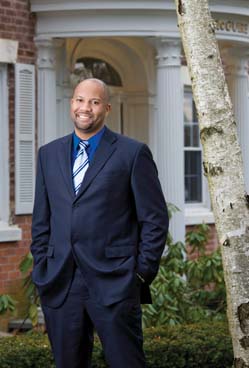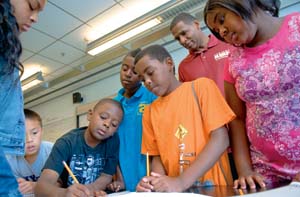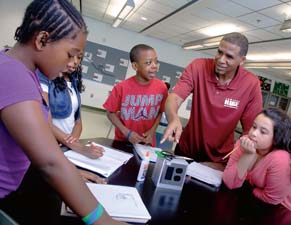 |
 |
| current issue |  |
past issues |  |
send a letter/news |  |
address update |  |
advertise |  |
about us |  |
alumni home |
Features
The Rebound TeamPage 2 of 4
 Lisa Nugent/UNH Photographic Services
Lisa Nugent/UNH Photographic ServicesDale Taylor, an associate admissions officer at Siena College, says Project RISE saved his life. |
Dixon got the idea for Project RISE one day in 1993 as he was watching his son play a video game and worrying about his exposure to screen violence. He was also disturbed by the persistence of real-life violence in his community—recent shootings had just claimed the lives of two more young men he knew. "That was the spark," says Dixon, who launched the program with $17,000 (from a friend, Danny Wood, of the band New Kids on the Block), three teachers and 17 African-American teens, half of whom had been referred by their probation officers.
Since the first year, the intensive academic and cultural enrichment program has grown to enroll as many as 300 students each summer, with a staff of 30 teachers and counselors, many of whom are Project RISE graduates. Most students accepted into the six-week program (which is located at, but not sponsored by, Thayer), come back year after year. And each September, when Project RISE kids return to their public schools, they almost always find themselves ahead of their peers, sometimes having advanced a grade level in math or English. They often have more confidence, more motivation—and, for the first time, they have goals. They see college in their future. And careers. During the school year, homework sessions on Saturdays keep kids on track and in touch. "We have very little attrition," says Dixon, who notes that 80 percent of the students return each summer. "There's a constant waiting list."
Dixon describes the program as a careful blend of challenging academics and enrichment activities, powered by staff members who serve as mentors and role models. "It takes a special kind of person to teach these kids," he says. "The main thing I look for is character. Degrees and academic accomplishments mean very little. They have to be able to handle diversity, to motivate kids who don't want to learn."
 Lisa Nugent/UNH Photographic Services
Lisa Nugent/UNH Photographic Services |
Project RISE is different from other programs for at-risk youth, explains Mike Sheehan, a Thayer Academy board member who has known Dixon since their days as students and teammates at Thayer. "The program isn't just about getting kids off the street and giving them something to do," he says. "Rob convinces them that they can achieve at the highest level. He pushes them to their limits—and a lot of these kids have never been pushed before." Sheehan, who is CEO of the advertising giant Hill Holliday, remembers Dixon as a role model early on. "I learned a lot about leadership from Rob," he says. "He pushed us to be a better basketball team. He's very quiet, but he knows how to get people to achieve excellence."
DURING A SUMMER DAY at Project RISE, the 6-foot-3 executive director is clearly at the center of everything—dropping in and out of classrooms, high-fiving students in the hallway, calling kids on their bad language, sitting down one-on-one to talk when somebody needs a listening ear. Dixon and his wife, Almanda, the sister of his UNH teammate McClain (who runs a youth basketball league in nearby Roxbury), maintain an open-door policy at home, too, setting extra places at the dinner table when students stop by, hosting movie-and-popcorn nights, and providing extra beds. Like Dixon's three kids, who have grown up with the program, attending as students and later as counselors, Project RISE participants are part of the family. "These kids need to feel like they belong to something larger than themselves," he says. "Something that will be there for them, something they can come back to."
In 2009, the program received national recognition when Dixon was chosen from thousands of nominations in the "All-Stars Among Us" initiative created by People magazine and Major League Baseball. Before a television audience and sold-out Busch Stadium in St. Louis, Dixon stood with the 29 other top winners as all five living U.S. presidents appeared in a video salute to the volunteers. In his comments, former President George W. Bush praised Dixon, and the two met later in Dallas to discuss the program. But Dixon brushes aside the laurels. "What I do isn't extraordinary," he insists. "It may have extraordinary results, but it should be a natural thing that people give back to their communities. It's just what you do."
 Lisa Nugent/UNH Photographic Services
Lisa Nugent/UNH Photographic Services |
DALE TAYLOR'S INITIAL MEETING with Dixon was rough. "I didn't want to hear anything he had to say," says Taylor, who was being arraigned in court for resisting arrest. "There was no way I could imagine leaving the only life I knew." Not long after their meeting, however, Taylor got a phone call. It was his best friend. He was 17, and he'd just been sentenced to three years in jail. "It was his first time in an adult jail," says Taylor, "and he called me crying." Taylor, who was 14, made up his mind to ask his probation officer for a second chance. And Dixon agreed to meet again, ignoring a school administrator who told him not to waste his time. "He was sure," he says, "that this kid wasn't going to amount to anything." Nothing irks Dixon more than adults who give up on kids. Where others may see a hopeless case, he sees a challenge—a kid with untapped potential. And so, in 1993, the summer before ninth grade, Taylor found himself enrolled in Project RISE.
The culture shock nearly knocked the wind out of him. "I hated it," says Taylor of his first days in the program. "I felt stupid and intimidated. I had to read out loud in class for the first time. I was used to teachers who just looked at the newspaper during class, who didn't care what we did." Dixon knew exactly what Taylor was facing. "When I meet these kids, it's like seeing myself when I was younger," he says. And he understood they'd need support. Every day after school, Taylor and many of the other students left Thayer's polished classrooms and went home to neighborhoods where their friends were getting arrested and going to jail and where there were memorials on nearly every street corner for shooting victims, many of them children.
Page: 1 2 3 4 Next >
Easy to print version
blog comments powered by Disqus
